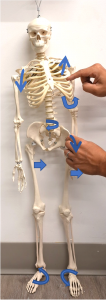Have you heard about “T4 syndrome”or “upper thoracic syndrome”?
T4 syndrome or upper thoracic syndrome is a condition that the dysfunction of the thoracic spine can make a refer pain and paraesthesia to the upper limbs and the hands. It is a diagnosis of exclusion because no one knows the exact cause of it. The theory of T4 syndrome is due to the sympathetic outflow to the upper limb is supplied by levels T2-5. Because of the upper thoracic girdle dysfunction, the sympathetic nervous system could provide a pathway for referral from the thoracic spine to the upper limb.
It is important to note that T4 syndrome is reported to be approximately three times more common in women than in men, although the reasons behind this gender disparity are not yet fully understood. As the exact cause of T4 syndrome remains uncertain, diagnosis is typically made after other potential causes of the symptoms have been ruled out through a comprehensive evaluation conducted by a healthcare professional.
Symptom associated with T4 syndrome
- Subjective reports of parasthesia, altered and extreme temperature perception and “puffiness” in the glove distribution of both hands
- A history, or current complaint of intermittent posterior thoracic pain or pain around the scapula region
- Symptoms worse last thing at night or with activities involving thoracic flexion/slumping (e.g sitting at a computer/desk for long periods, laying with pillows under your head)
- Position of most comfort tends to be laying completely flat (supine)
Objective findings include:
- forwarded headedness (straight neck) and cervico-thoracic kyphosis
- Flattened upper thoracic spine (T2-7)
- Minimal thoracic movement during single arm elevation to either side
- Notable restriction in upper thoracic movement
- Positive upper limb tension tests, often limited on both sides by pain across upper thoracic spine
- Positive slump test (neural tension in lower extremities)
This T4 syndrome is three times more common in women than men. (Cited from https://www.shoulderdoc.co.uk/article/1630)
PRI: “Superior T4 syndrome” explains T4 syndrome!

In a typical human pattern, our pelvis rotated to the right (L AIC pattern). As compensation for it, the thoracic spine turns to the Left in order to turn the face straight forward.
However, some individuals further over-compensate the system by turning the upper thoracic spine (T4 level) to the right, creating torque in the thoracic spine.
This pathological state calls Superior T4 syndrome in PRI.
The upper 2-3 ribs on the right may be in a state of compensated external rotation because of the effort of the right scalenes, upper trapezius and subclavicular muscle.
This external rotation position of the upper right ribs assists with pulling air in on the right chest with accessory musculatures because the chronic pattern of L AIC does not expand the left posterior mediastinum and the right apical chest efficiently.
Therefore in Superior T4 syndrome, the upper 3 or 4 vertebral bodies remain oriented or rotated to the right on the other hand the lower vertebral bodies are oriented to the right as an influence of the left AIC
As a result of superior T4 syndrome, the thoracic spine is extremely in a dysfunctional state and the sympathetic nervous system is under tremendous stress (Or you could say, because of your sympathetic state, you create superior T4 syndrome).
We see more and more New Yorkers are in superior T4 compensatory pattern and the symptoms are wide range as follow:
- Pain in the thoracic spine
- Pain between the shoulder blades.
- Pain in posterior rib pain (could be right or left)
- Shoulder dysfunction: rotator cuff issues, shoulder impingement, frozen shoulder, biceps tendinitis
- Epicondylitis
- Neck pain
- Temporomandibular dysfunction (TMD)
- Headaches